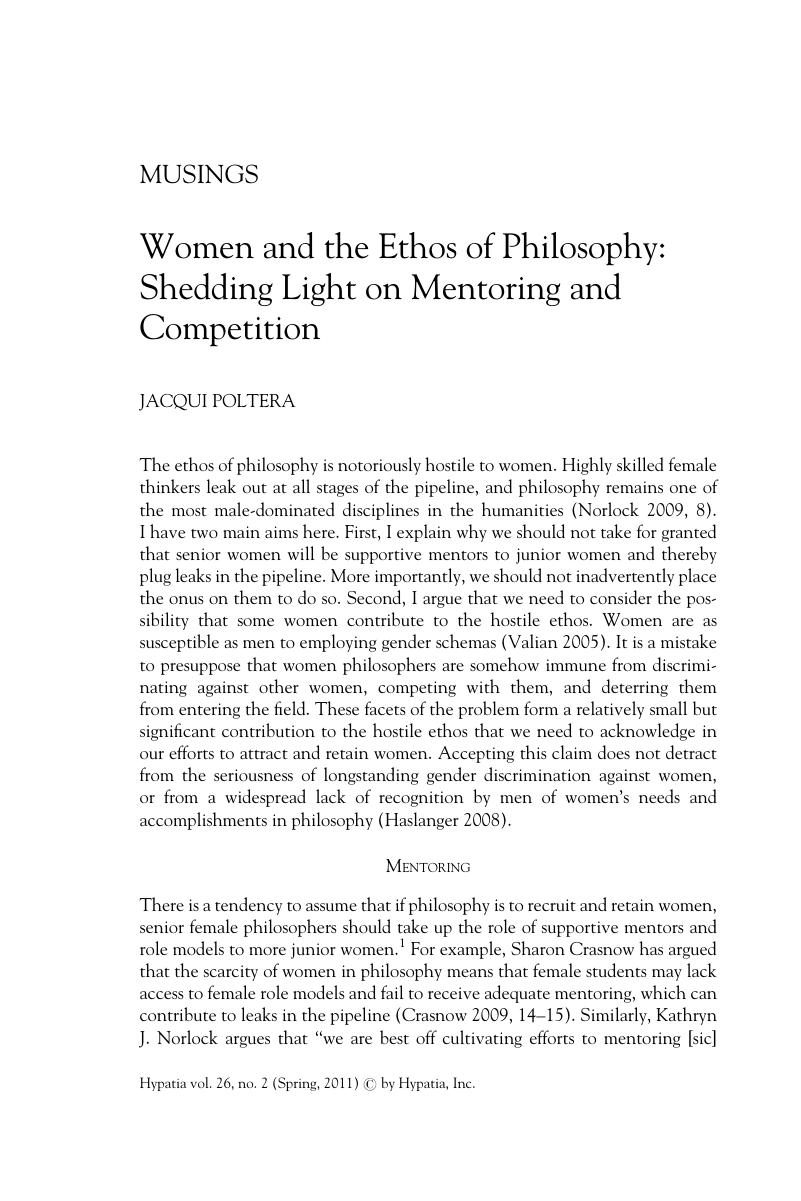No CrossRef data available.
Article contents
Women and the Ethos of Philosophy: Shedding Light on Mentoring and Competition
Published online by Cambridge University Press: 11 March 2020
Abstract
An abstract is not available for this content so a preview has been provided. Please use the Get access link above for information on how to access this content.

- Type
- Women in Philosophy
- Information
- Copyright
- Copyright © 2011 by Hypatia, Inc.
References
Crasnow, Sharon. 2009. What do the numbers mean? APA Newsletters on Feminism and Philosophy 8 (2): 13–6. http://www.apaonline.org/documents/publications/v08n2_Feminism.pdf (accessed September 22, 2010).Google Scholar
Goddard, Eliza, et al. 2008. Improving the participation of women in the philosophy profession. Prepared by the Committee of Senior Academics Addressing the Status of Women in the Philosophy Profession. http://www.aap.org.au/women/reports/IPWPP_ReportA_Staff.pdf (accessed September 22, 2010).Google Scholar
Haslanger, Sally. 2008. Changing the ideology and culture of philosophy: Not by reason (alone). Hypatia 23 (2): 210–23.CrossRefGoogle Scholar
Kourany, Janet A. 2009. Why are women only 21% of philosophy?: Introduction to the panel presentations. APA Newsletters on Feminism and Philosophy 8 (2): 9–10. http://www.apaonline.org/documents/publications/v08n2_Feminism.pdf (accessed September 22, 2010).Google Scholar
Lunbeck, Elizabeth. 2005. The status of women in the historical profession. Prepared for the American Historical Association Committee on Women Historians. http://www.historians.org/GOVERNANCE/cwh/CWH‐Report_5.20.05.pdf (accessed September 22, 2010).Google Scholar
Miner, Valerie, and Longino, Helen E., eds. 1987. Competition: A Feminist Taboo. New York: The Feminist Press at CUNY.Google Scholar
Moulton, Janice. 1993. A paradigm of philosophy: The adversarial method. In Discovering reality: Feminist perspectives on epistemology, metaphysics, methodology and the philosophy of science, ed. Harding, Sandra and Hintikka, Merrill B.P.Dordrecht: Kluwer Publishing.Google Scholar
Norlock, Kathryn J. 2009. Love to count: Arguments for inaccurately measuring the proportion of philosophers who are women. APA Newsletters on Feminism and Philosophy 8 (2): 6–9. http://www.apaonline.org/documents/publications/v08n2_Feminism.pdf (accessed September 22, 2010).Google Scholar
Solomon, Miriam, and Clarke, John. 2009. CSW Jobs for philosophers employment study. APA Newsletters on Feminism and Philosophy 8 (2): 3–6. http://www.apaonline.org/documents/publications/v08n2_Feminism.pdf (accessed September 22, 2010).Google Scholar
Stewart, Abigail J. 2009. What might be learned from recent efforts in the natural sciences? APA Newsletters on Feminism and Philosophy 8 (2): 16–9. http://www.apaonline.org/documents/publications/v08n2_Feminism.pdf (accessed September 22, 2010).Google Scholar
Valian, Virginia. 1998. Why so slow? The advancement of women. Cambridge, Mass.: MIT Press.Google Scholar
Valian, Virginia. 2005. Beyond gender schemas: Improving the advancement of women in academia. Hypatia 20 (3): 198–213.CrossRefGoogle Scholar
Wasson, Christina, et al. 2008. We've come a long way, maybe: Academic climate report of the Committee on the Status of Women in Anthropology. Prepared for the American Anthropological Association. http://www.aaanet.org/resources/departments/upload/COSWA‐Academic‐Climate‐Report‐2008.pdf (accessed September 22, 2010).Google Scholar
Wylie, Alison, Jakobsen, Janet, and Fosado, Gisela. 2007. Women, work, and the academy: Strategies for responding to “post‐civil rights era” gender discrimination. Published by the Barnard Center for Research on Women. http://www.barnard.edu/bcrw/newfeministsolutions/reports/NFS2‐Women_Work_and_the_Academy.pdf (accessed September 22, 2010).Google Scholar


